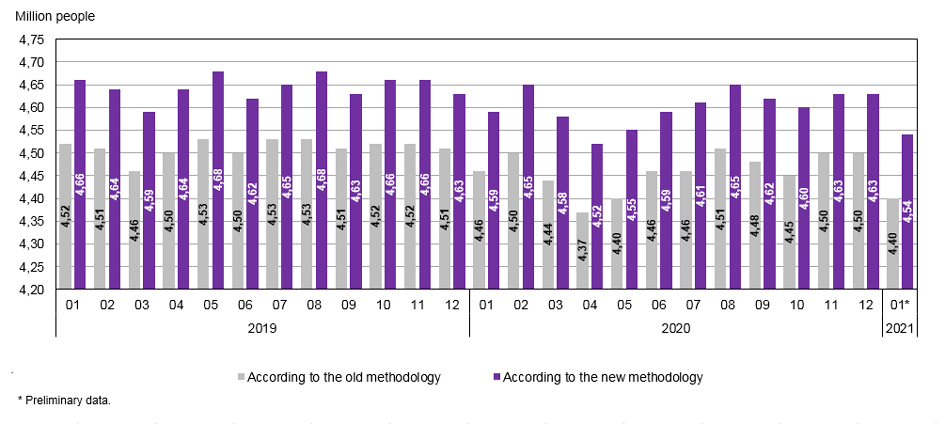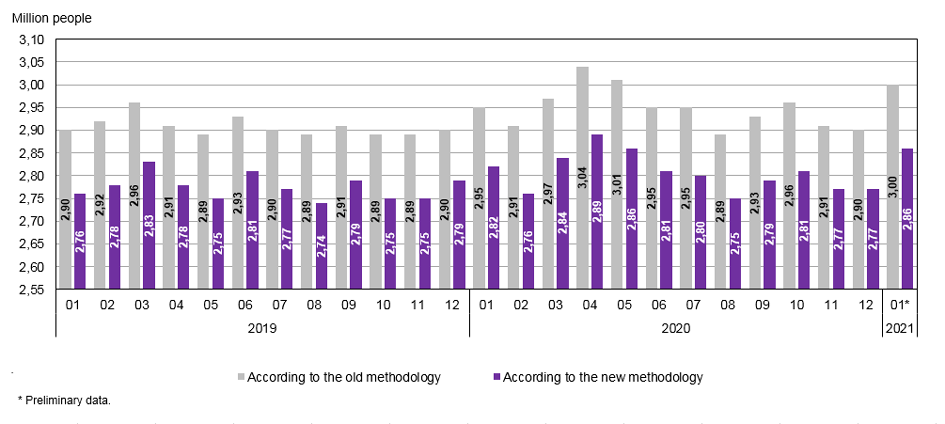Press release, 26.02.2021.
HCSO starts to release labour force survey data according to a new methodology
The Hungarian Central Statistical Office (HCSO) started publishing labour force survey data according to a new, international regulation harmonized methodology with the January 2021 reference period. In the first month of the year, these data showed 4 million 537 thousand employed and 2 million 864 thousand non-employed in Hungary. Women's activity indicators are especially impacted by this: in addition to active workers receiving childcare benefits (GYED, GYESE)1, those who worked before the parental leave, receive job-related income and are guaranteed to return to their previous job are also considered employed due to the new EU regulation.
HCSO started publishing labour force survey data according to a new methodology with the January 2021 reference period. On 1 January 2021, an EU Framework Regulation on Harmonized Population Data Collection2 with related Implementing Regulations (IESS)3 entered into force: this is the reason for this change. Many areas of European and domestic household statistical data collection, in particular labour force surveys, are impacted by this regulation.
In January 2021, data according to the new methodology showed 4 million 537 thousand employed and a 71.1% employment rate (4 million 403 thousand employed and a 68.9% employment rate were recorded according to the old methodology). At the same time, 2 million 864 thousand people were unemployed or inactive (2 million 997 thousand people according to the old methodology).
Certain categories of economic activity are differently classified by the new methodology: in addition to active workers receiving childcare benefits, those who worked before the parental leave, receive job-related income and guaranteed to return to their previous job are also considered employed due to the new EU regulations. In Hungary it ensues a 120–150 thousand growth in employment, especially impacting female activity rates. Furthermore, students, unpaid family workers, and seasonal workers are also counted differently due to this methodological change without significantly changing employment data.


Data recalculated until 2009 according to the new methodology can be found on the HCSO website in the STADAT summary tables (Theme 2.1 Labour market). Data according to the previous methodology will also remain available by clicking on the 'Data generated by the previous methodology until 2020' link in the table of contents for this topic.
Social statistics in the European Union have been undergoing modernization for almost ten years, with the aim of better responding to user needs, improving timeliness and meeting information needs cost-effectively. Former individual, data collection-specific rules become more integrated and flexible in social statistics due to the new framework regulation that came into force on 1 January 2021. Areas covered by the new regulation: labour, income and living conditions, health, education, time use and consumption.
1Childcare allowance.
Related Press Release - Changes in next year’s household surveys (03.12.2020.): http://www.ksh.hu/press_release_03_12_2020
Hungarian Central Statistical Office
H-1024 Budapest, Keleti Károly u. 5-7. Phone: +36 (1) 345 6000
Postal address: P.O.B. 51 Budapest, H-1525
http://www.ksh.hu